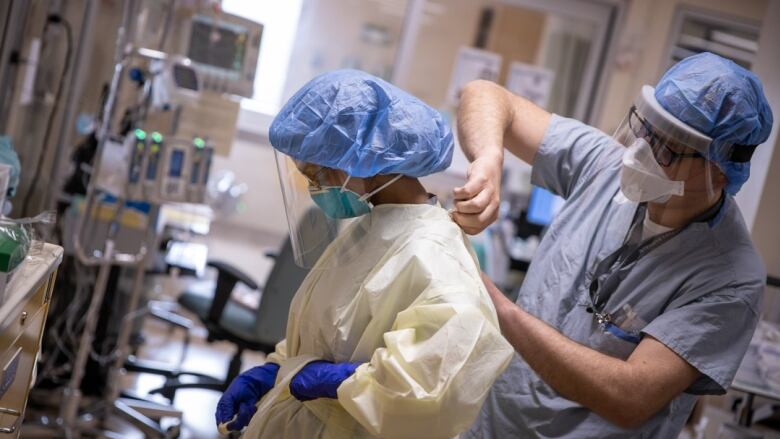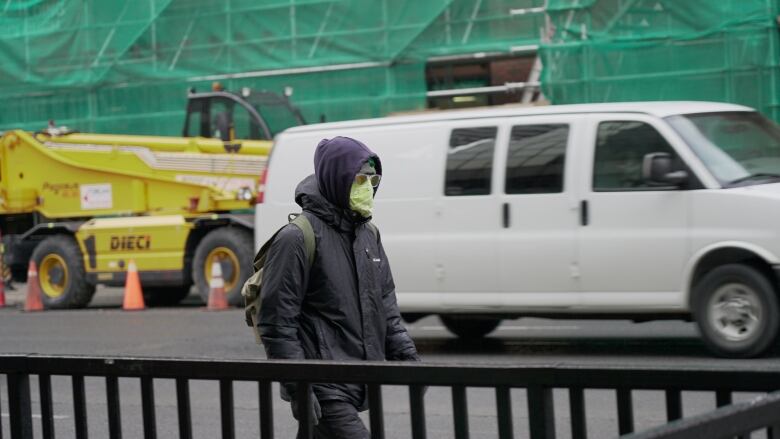COVID-19 came to Hamilton 6 months ago today here's a look at the toll it has taken
How did Hamilton compare to neighbouring regions for cases, outbreaks and deaths?

This story is the first in a seriesthat marks the 6-month anniversary ofCOVID-19 hitting Hamilton andwill examine itsimpactspast and future on the city.
Six months have passed sincethe day Hamiltonians learnedCOVID-19 had arrived in the city. On March 10, 2020, a radiation oncologistat the JuravinskiCancer Centre got officialword she hadtested positive for the virus.Then things happened in a rapidblur.
Students and staff, who left schools with thoughts of an extended March break, arejust returning this week and next and only some of them have chosen to walk the halls.
Half a year since that first case, public health says 1,017people are known to have had the virus in the city, with 87active cases right now.
Here's a lookat the numbers that show the toll the virus has taken on the city and its residents, and where possible how the city fared relative to neighbouring cities and regions.
(Unless otherwise noted, numbers are as of publicly available data on Sept. 1)
Hamiltonians who died from the virus: 45
Canada confirmed its first case of the virus on January 20, and scientists continue to work around the world to studyits unpredictable nature in search of a vaccine.
The virus has taken the lives of 45 people in Hamilton, 25 in Halton, 64 in Niagara, and 120 in Waterloo.
Hamilton's first death came March24, two weeks after its first case, when an 80-year-old resident of a nursing home died in hospital.
Per 100,000 people, andusing populations from the 2016 census, that's a rate of a provincial rate of 20.9.
Hamilton falls below at8.38, and its surrounding areas include4.56 for Halton; 14.29 for Niagara; and 22.42 for Waterloo.
The number ofCOVID-19 patients hospitalized:148
Health-care workers, unnerved by the virus and steeling themselves for ethical dilemmas, put themselves at riskto staff thefront lines.At one point in early May, they accounted for almost a quarter of those with the virus.
Hospital workers treated 14.8 per cent of the city's confirmed and probable cases.
In Niagara10.7 per cent of those known to be sick with the virus were hospitalized, working out to around 100 people. Three per cent of cases were admitted into the ICU.
In Waterloo 120 people have been admitted to hospital, and60 were in the ICU.Hamilton Health Sciences and St. Joseph's have not revealed their ICU numbers.
The highest number of COVID-19 patients treated at one time by Hamilton's hospitals:36 and39
Unsure of when or whether the virus surge would arrive, the hospitals prepared for a surge in April in hopes they would have space for the onslaught.HHS readied 300 beds for COVID-19 patients, and St. Joseph's had 150 beds.

Thirty six people at St. Joseph's, across May 21 and 22, was the highest numberof patients with the virus ever admitted at one time.At Hamilton Health Sciences, 39 people was the most patients being treated at one time.
The day with the most reported new cases: 61 cases on May 15
After that first report saying the virus had come to Hamilton, it took three weeksfor confirmed and probable cases to goover the 100 mark. Then its pace slightly quickened; it tookjust short of two weeks later, until April 13 the day after Easter Sundayto reach 150 more.
By then the city was mostly shut down, and the virus' ability to spread seemingly weakened. A month went byfor those cases to double and reach over 500 on May 13.
But a couple of days later, new reports spiked with a devastating outbreak.
The number of outbreaks in long-term care and retirement homes: 3 and 8
The Rosslyn Retirement Residence was evacuated on May 15 after an outbreak infectedall but two of the 66 residents and 22 staff members.
Sixteen people died, and their lives accountfor about athird of all COVID-19 deaths in Hamilton.
In all, the city says it saw three outbreaks in LTC homes and eight in retirement homes.
Those are below the numbersseen in Halton (20 in LTC and retirement homes and one in a hospital); Waterloo (38 and 4 in hospitals); and Niagara (37 outbreaks total.) Halton saw 12 people die from outbreaks and Waterloo saw96 deaths.
The day Hamilton hit 1,000 total cases: September 1
The Waterloo region struggled with their LTC home outbreaks and reached over 1,000 confirmed cases two days after Hamilton reached the 500 (confirmed and probable) mark on May 13.
And it took Hamilton longer than the surrounding regions to get there. Haltonhad hit this number two weeks earlier, and Niagara reached 500 confirmed cases (which doesn't even include probable ones) by May 2.
Hamilton hit 1,000 total cases last weekon September 1.
The number of people who got the virus from an outbreak: 255
When the virus got into LTC and retirement homes across the province, it ravaged.
As of Sept.3, the province had424 outbreaks in LTC homes, 190 in retirement homes, and 98 inhospitals.In Niagara, over 60 per cent of the total cases were associated with an outbreak.
In Hamilton, it remains the largest single reason for how people caught the virus. Here's thebreakdown, as of Sept. 2 ofhow people in Hamilton got the virus.
- A quarter of all casescontracted the virus because they were associated with an outbreak.
- Eight per cent have direct travel history.
- 36per cent caught the virus through close contact.
- 31 per cent were community acquired.
- One case was under investigation.
The area with the highest rateper 100,000 people: Delta West with 65 positives
Delta West, the neighbourhood around the Rosslyn, the site of Hamilton's deadliest outbreak, hasthe highest rate of cases per 100,000 people.
The next highest is downtown beside St. Joseph's, between Aberdeen Avenueand Hunter Street W, andBay and James with 57 cases.
Places hit the hardest, revealed by aSocial Planning and Research Council of Hamilton(SPRC) study, were home to more people of colour and more low-income residents.
Here are some of their numbers from early August:
- Average cases of COVID-19 per 100,000: 136
- Average cases in the wealthier areas: 99
- Average cases in areas with the most material deprivation: 179
- Average cases in areas with a low rate of residents who identify with a racialized group: 81
- Average cases in areas with the highest rate of residents who identify with a racialized group: 196
The study also showed job losses in Hamilton affected women, youth and part-time workers the most.
And while Hamilton doesn't have this figure readily available, Niagara, Halton, and Waterloo all report that more women also contracted the virus.
Hamilton's public health will report to the board of health with an analysis on COVID-19 numbers on Sept.21.
The number of jobs lost from February to May:46,000
To keep the virus's spread contained and prevent an unbelievable strain on the health-care system, the province ushered in astate of emergency, marked bycancellations ofparades and drinking plans on St. Patrick's Day.
As the pandemic raged on, Hamilton lost the most jobs almost 46,000 compared to its surrounding regions fromFebruary to May, according to numbers from Ontario's financial accountability office.
Its report said31,600 jobs were lost in commercial-reliant Niagara, and Mayor Jim Diodatisaid that 98 per cent of the 40,000 people who work in Niagara's battered tourism sector had been laid off.
The report also said Waterloo lost 39,500 jobs.
The age group with the most amount of cases: ages 20 to 29
People in their twenties the age group that inspired the city at one point to turn to French bulldogs to communicate physical distancing continue toaccount for 21 per cent of positive tests.
Even younger people are continuing to get the virus, a trend that predates people heading back to class. The most common age in the last 10 days leading up to Sept. 1 was 10-19. In the last 10 days, it has been ages 20-29, tied with 30-29.
This is similar to Niagara, whose age group with the highest number of cases is 20 to 39, followed by those 40 to 59.
Halton cases have trended older, with 33.7 per cent of people with the virusaged 40 to 59, and 20 - 39 making up over 28 per cent.

The number of people charged under the physical distancing bylaws: 135
Ignoring the city's instructions to keep apart meanta $500 finefor 135 people. The city said it doled out that many charges ofits two physical distancing bylaws (the new one being brought in after the first ended with the province's state of emergency.)
The new one saw two people charged for holding house parties.
Here's how all 135 charges broke down over the past months:
- Not maintaining a distance of at least 2 metres from another person: 24
- A proprietor failing to ensure physical distancing in public space: 1
- Attending/using a closed city of Hamilton or HRCA property: 94
- Attending a gathering of more than fivepeople: 8
- Obstructing an officer or authorized staff: 6
The dive in April housing sales compared to last year: 63.4 per cent drop
April was the worst of it for the housing market. Sales plummeted amidst the early weeks of the pandemic, with the Realtors Association of Hamilton-Burlington saying only 482 places were sold.
That was a 63.4 per cent drop from the same month in 2019, and a 56 per cent decrease from March. Sales stayed down in May, a drop of 42.2 per cent compared to the month in 2019.
As time pressed on and the summer months rolled by, more listings hit the market and more homes were sold.The RAHBsays sales are down in August compared to July, but still up 12.7 per cent compared to the same time last year.
And despite the dip, homes are still getting pricier. The average price of a residence in August was $694,690 which was up 0.24 per cent from July and 16.3 per cent from last year.












_(720p).jpg)


 OFFICIAL HD MUSIC VIDEO.jpg)
.jpg)



























































































